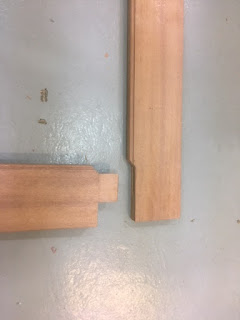Wow, that title sounds a bit pompous and self righteous..
About a year ago I wrote a post about an idea I had: t
o make some ready to assemble kits of small ships for the local kindergarten.
I finally got my act together and moved a lot of the scraps from the barn at the summer house back home.
With the Barnsley table complete, I just had time to tackle this small project prior to returning to sea.
The overall design of the ships is inspired by ferries of the 1950'ies-1960'ies. Back when masts were still used for holding the radio antennas and technically also for the booms for cargo handling.
I removed the tongue from the boards and split them to make some 6 cm (2.375") wide strips.
These would form the hull.
All of those were sawed to the same length of 27 cm (10.75").
I made a jig to enable me to make a cut for the bow that would result in something like a 60 degrees angle (eyeballed). It looks better to me than just having two 45 degrees bow portions meet.
A bunch of superstructures were made next. 4 cm (1.6") wide and 11 cm (4.375") long.
I purchased a broom stick and made a run of funnels from that one. Each funnel 2.8 cm (1.125") long.
After thinking a bit, I came to the conclusion, that it was easier for me to buy all the stuff that was needed for the project instead of giving more jobs to the adults at the kindergarten. So I went to the lumberyard and purchased a box of nails that would be appropriate for the thickness of the wood, and some long pieces of pine dowels all 8 mm thick (5/16").
All the masts were sawed of at a length of 12 cm (4,75")
I clamped on some pieces of scrap to the table of the drilling machine to work as a jig for boring multiple holes in the same position. Holes were drilled in the hull for the masts, and in the superstructure and the funnel to act as pilot holes for nails.
I didn't sand the pieces since I figured that it would be something the kids could do themselves, and it would give them a greater sense of ownership in the process.
All parts were neatly packed in a small cardboard box, a small roll of sand paper, a handful of nails were put in a small plastic bag and finally a quart filled glue bottle was put in the box with it all.
I assembled one ship out of a damaged hull piece, so that they could use it as a template.
The ship is made out of 5 pieces of wood and uses 3 nails, so it is not the most complicated build that I have ever made.
A total of 36 kits were handed over to the kindergarten, and I asked how many kids they had, so I could have made a couple of more if needed, but they assured me that it was fine.
The remaining pieces of scrap were turned into lengths of strips with various sizes, so that they could make something else from their own design later on.
Regarding the title of this post, I have invested a bit of time, say maybe 2 hours of efficient work in making the kits. The scrap wood would most likely have ended up as fire wood so despite that it originally had a cost, I value it to zero.
the broom stick was 4$, the three long dowels (each 14' long) were a total of 12$.
The package of nails was 9$, so a handful of that is maybe 2$.
Sandpaper and the remains of my old glue bottle is maybe another 5$.
A grand total of 32$, (equivalent to the price of one and a half beer at a Norwegian airport) plus some hours of work was what it cost me.
My hope is that perhaps one day in the future one of those kids will remember that making things out of wood was fun, and will take up woodworking as a hobby. Or perhaps they will bring the ship home with them and show it to their parents, and someone will try to make something similar on their own.
When Gustav was in kindergarten, I helped them one day by casting hammers of Thor (Mjølner) out of molten tin. Approximately half a year ago, Gustav told me that a girl in his class remembered casting those 11 years ago when they were 4 years old. So I reckon that if you can make something a success when you are 4 years old, you might just remember it later on in life, and it might be the start of a good hobby.
Future investment ship template.
Lightly damaged port bow.
ripping the tongue from the board.
Bow making jig.
The rest of the scrap wood turned into various sizes of strips


















































